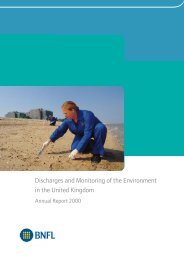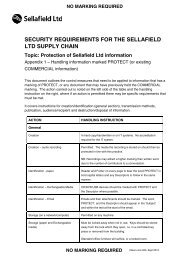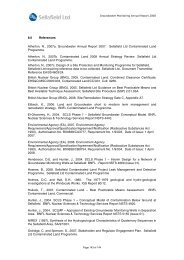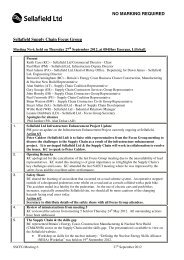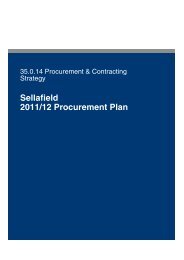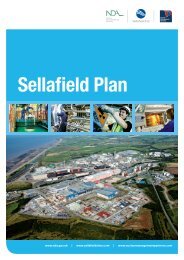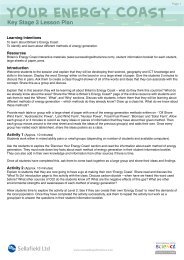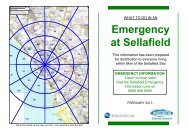Annual Report for 2010/11 and Forward Programme - Sellafield Ltd
Annual Report for 2010/11 and Forward Programme - Sellafield Ltd
Annual Report for 2010/11 and Forward Programme - Sellafield Ltd
You also want an ePaper? Increase the reach of your titles
YUMPU automatically turns print PDFs into web optimized ePapers that Google loves.
Page 2 of 3provides useful in<strong>for</strong>mation on find numbers over time <strong>and</strong> possible rates of repopulation.The requirement <strong>for</strong> str<strong>and</strong>line monitoring has also been incorporated into the programme atappropriate quarterly intervals. This monitoring, which is less time consuming than large areabeach monitoring, has been identified alongside the need <strong>for</strong> regular vehicle maintenance.Braystones beach, with its relatively high find-rates <strong>and</strong> greater public occupancy levels than<strong>Sellafield</strong>, will continue to dominate as the beach with the largest target monitoring area. As inprevious years, monitoring will be done a number of times, in large period blocks during theprogramme year.A key feature of the 20<strong>11</strong>/12 programme is the introduction of larger blocks of Buffer Time. Inprevious programmes, week-long blocks have been incorporated to allow <strong>for</strong> recovery of theprogramme in the event that un<strong>for</strong>eseen circumstances (eg inclement weather or technicalcomplications) impact on the ability of the contractor to achieve beach target areas in anygiven monitoring block. This year, in response to concerns raised by local stakeholders aboutpossible detrimental aspects of beach monitoring operations during peak tourist seasons,<strong>Sellafield</strong> <strong>Ltd</strong> are proposing to introduce extended Buffer Time blocks around the Easter <strong>and</strong>Summer school holidays. This will mean that routine monitoring will not be scheduled to takeplace during these times, (allowing time <strong>for</strong> major vehicle maintenance etc. to be carried out ifrequired), unless extenuating circumstances require it. Where monitoring is required duringthe buffer time, all ef<strong>for</strong>ts will be made to avoid those beaches with the highest publicoccupancy.Recognising the introduction of two extended buffer periods, those beach areas with thehighest public occupancy rates are scheduled to be monitored as close as possible to the start<strong>and</strong> finish of these periods. For example, St Bees beach will be monitored twice between theEaster <strong>and</strong> Summer buffer periods <strong>and</strong> again soon after the Summer buffer weeks. Thisshould mean that monitoring takes place at times that are most representative of periods whenthe beaches have their highest occupancy, but without the adverse impacts of monitoringwhen large numbers of the public are present.As a result of introducing these repeat visits either side of the buffer periods; <strong>and</strong> by breakingthe majority of monitoring periods down into week-long blocks at each beach, the number ofmonitoring visits to St Bees <strong>and</strong> Seascale will be increased as part of the 20<strong>11</strong>/12 programme.As with the <strong>Sellafield</strong> beach re-visits, these repeat surveys will help in<strong>for</strong>m underst<strong>and</strong>ing offind numbers <strong>and</strong> possible re-population rates.As part of the <strong>2010</strong>/<strong>11</strong> programme two periods of Investigative monitoring were introduced,providing the opportunity to return to some of the less-visited beaches <strong>and</strong> to monitor newbeach areas, utilising both vehicle <strong>and</strong> h<strong>and</strong>-held equipment (<strong>for</strong> those areas inaccessible tothe vehicle). For 20<strong>11</strong>/12 we are including beach areas from last years’ investigations asnamed beach areas in the programme (Allonby, Whitehaven North <strong>and</strong> Harrington); togetherwith a non-beach specified Investigation period. The specific inclusion of Allonby, WhitehavenNorth <strong>and</strong> Harrington, recognises the interest in continued monitoring on beach areas to thenorth of St Bees where a small number of finds have been recovered on some of the previousvisits. A decision on how best to allocate the Investigation period will be made closer to thetime; <strong>and</strong> will be based on findings from the monitoring carried out up to that point in theA company owned by Nuclear Management Partners <strong>Ltd</strong>Registered Office: Booths Park,Chel<strong>for</strong>d Road, Knuts<strong>for</strong>d, Cheshire WA16 8QZCompany Registration No. 1002607



